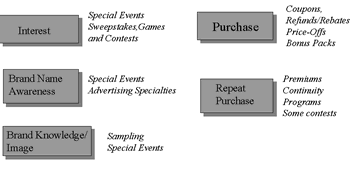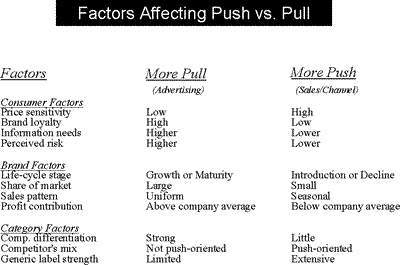Advertising and Promotion are tactics used to reach and influence the market. But they typically have different objectives and roles in the marketing mix. Understanding these different objectives helps us to employ the tactics in a more effective manner.
ADVERTISING
Advertising is generally targeted at end users (as opposed to the channels of distribution). It can be used for many purposes, including establishing awareness, providing information for knowledge, and creating brand loyalty. In its knowledge role, advertising can communicate a positioning (or modify a positioning) and even promote new uses of a product (think "Orange Juice isn’t just for breakfast anymore").
By focusing on-end users, advertising can indirectly influence the channels of distribution. This is because if advertising is effective in generating interest in a product, the channels may be more interested in carrying the product. When this happens, advertising "pulls" the product through the channels. For this reason, we tend to call advertising a "pull strategy".
Sometimes advertising is used to enhance a company’s "goodwill", so we feel better about a company. While not directly related to a specific product, these types of ads are useful in building an overarching brand identify.
PROMOTION
Promotion is a general term. It is so general, in fact, that most communications that are not strictly advertising (paid and non-personal) are characterized as promotions. But this distinction is blurry at times, so looking for a clear definition is useless. It’s better to just recognize that there are many types of promotions.
Some promotions are aimed directly at consumers (e.g., special events, sampling, rebates, coupons, etc.). The use of these promotions can typically be tied to the hierarchy of communication effects model.

ADVERTISING VERSUS CONSUMER PROMOTIONS
When thinking about advertising and consumer promotions it useful to consider  that each tends to place an emphasis on different benefits. This is because consumer promotions tend to be more price-oriented, while advertising tends to focus more on non-price benefits. Consider this relation to the concept of brand equity.
that each tends to place an emphasis on different benefits. This is because consumer promotions tend to be more price-oriented, while advertising tends to focus more on non-price benefits. Consider this relation to the concept of brand equity.
A product’s brand equity refers to the extent to which is has high loyalty, name awareness, perceived differentiation (among other things). Looking at the figure, note how advertising and promotion differentially affect a brand’s equity. For this reason, consumer promotions must be used carefully, especially when trying to maintain an image that is not based on price.
TRADE SALES PROMOTIONS
These are promotions directed at resellers or other members of the distribution channel. Again, there are different types including training programs, trade allowances, cooperative advertising, and the provision of point-of-purchase displays. These are intended to provide incentives to the channel to "push" a firm’s product. For this reason, we call trade sales promotions a "push strategy."
Various problems can arise when thinking about trade sales promotions and some of these are tied to the specific incentives in channel (see the incentive tutorial). One problem deserves attention here. That is, many retailers inventory products bought on trading allowances but then sell them at the regular price or divert them to other markets where there is no deal (i.e., they’re given a trade promotion to push the product, but they pocket the money and don’t push the product). This is something to consider when using trade promotions.
PUSH VERSUS PULL
Firms are often interested in whether they should push a product through the channel or use advertising as a means of pulling the product. This, of course, is a complicated decision but research (and clear thinking) indicates that various factors can be used to help make this decision.

Thus, for example (and I'm only considering three factors here), when consumers need information, the perceived risk is high, and its a growth market, more advertising should be used rather than pushing the product. In a similar manner, all these factors should be considered and balanced when making this decision.




